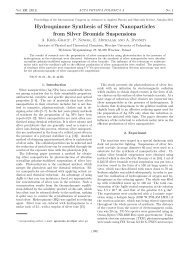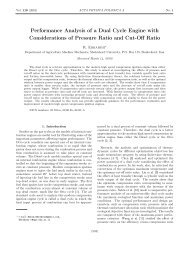Ultra Fine-Grained Metals Prepared by Severe Plastic Deformation ...
Ultra Fine-Grained Metals Prepared by Severe Plastic Deformation ...
Ultra Fine-Grained Metals Prepared by Severe Plastic Deformation ...
You also want an ePaper? Increase the reach of your titles
YUMPU automatically turns print PDFs into web optimized ePapers that Google loves.
750 J. Číˇzek et al.<br />
density, one can conclude that the concentration of defects decreases with depth<br />
in a surface layer of ≈ 18 µm thickness and at deeper layers remains unchanged.<br />
This decrease comes primarily from the decrease in concentration of microvoids<br />
with depth and also from a slight increase in grain size with depth suggested <strong>by</strong><br />
XRD investigations (see Ref. [11] for details).<br />
Radial dependence of defect concentrations was also inspected <strong>by</strong> PAS and<br />
SPIS. The following main results were obtained [11]:<br />
• There is no radial change in the mean grain size, a value of 120±20 nm being<br />
measured <strong>by</strong> TEM. This is in reasonable agreement with XRD findings. Also<br />
the dislocation density was found <strong>by</strong> XRD to remain unchanged with radial<br />
distance from the centre of disk.<br />
• On the other hand, it was found that size and density of microvoids vary<br />
with the radial distance from the centre of the sample.<br />
3.3. Thermal stability of UFG structure<br />
The investigation of the thermal stability of the UFG structures can contribute<br />
to understanding the physical processes in the UFG metals, but is also<br />
important from the point of view of the industrial application of these materials.<br />
Isochronal annealing curves were measured on HPT-made UFG Cu (two specimens<br />
prepared under 3 and 6 GPa pressure) and Cu+Al2O3. The difference in<br />
the pressure resulted in a difference in the mean grain size of the UFG Cu specimens,<br />
as measured <strong>by</strong> TEM: 150 and 105 nm, respectively. Annealing steps were<br />
30 ◦ C. Specimens were annealed for 30 min at each temperature. Each annealing<br />
step was finished <strong>by</strong> quenching to water of room temperature. In Fig. 1, the<br />
Fig. 1. The thermal evolution of volume fraction η of distorted regions along GBs<br />
with annealing temperature as obtained from the analysis of positron lifetime data<br />
within the diffusion trapping model [8]: UFG Cu (6 GPa) — open circles, UFG Cu<br />
(3 GPa) — filled circles and UFG Cu+0.5 wt.% Al2O3 composite — open triangles.





